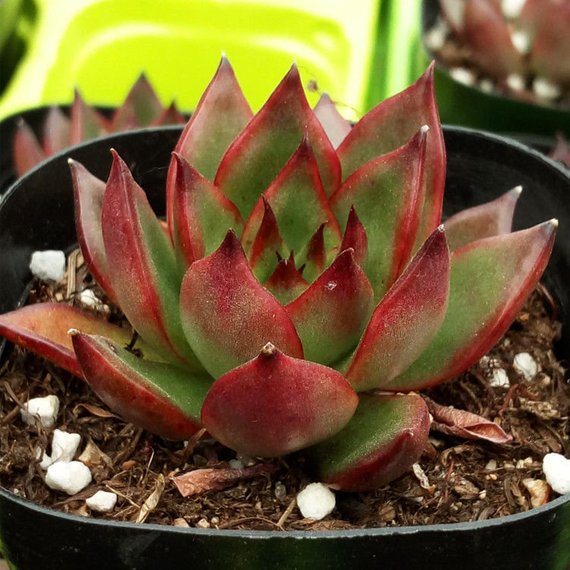Echeveria agavoides is a perennial succulent herbaceous flowering plant belonging to the Crassulaceae family, one of the varieties in the Dongyun series. As a popular choice for home succulent cultivation and decoration, it is deeply loved by succulent enthusiasts.
Echeveria agavoides typically grows up to 15 centimeters in height without a stem. Its leaves are arranged in a lotus-like pattern, thick and fleshy, elongated oval-shaped with a waxy texture. They are upright, slightly inwardly curved, and tapering towards the tip. The leaves are green, but under abundant sunlight and suitable temperature variations, they turn pink to deep red with shades of purple. The flowers emerge from leaf axils, arranged in umbels, with small orange-red petals, blooming from late winter to spring.
The root system of Echeveria agavoides is relatively well-developed. Therefore, it requires loose and well-draining soil for cultivation. A mixture of nutrient-rich soil and granular soil is recommended, with granular soil typically accounting for more than half of the total soil volume.
During its normal growth seasons, most leaves of Echeveria agavoides remain green. However, under abundant sunlight and controlled watering, the leaf tips will turn red, resulting in robust growth with thick and plump leaves. Adequate sunlight is crucial for enhancing the plant's appearance.
The spring and autumn seasons, with significant temperature differences between day and night, are ideal for Echeveria agavoides to develop vibrant colors. During this period, watering should be moderate to induce reddening of the leaves.
Propagation of Echeveria agavoides is relatively easy. Side shoots can be used for planting, or leaf cuttings can be taken, both of which will readily root and sprout.
Growing Environment:
Echeveria agavoides prefers abundant sunlight. Insufficient light may cause the leaves to elongate and turn green, affecting the compactness of the plant.
Sunlight:
Echeveria agavoides possesses excellent red color genetics. If the light conditions are insufficient, there will be less pressure for the leaves to turn red. However, to maximize its aesthetic appeal, the plant requires at least 8 hours of sunlight exposure daily (especially during winter, while other seasons may require less).
Repotting:
Every spring, Echeveria agavoides should be repotted to inspect its root system and disinfect the soil.
Watering:
While controlling water intake directly may not change the color of Echeveria agavoides's leaves, it can reduce the chlorophyll content within the leaves. With lower chlorophyll content, the leaves will naturally appear redder. Therefore, during the winter coloration phase, it's essential to control water intake.
Soil Mix:
For cultivating Echeveria agavoides, use soil with good drainage and aeration. A mixture of cinder, fine sand, and perlite is recommended, with a composition of 70% granular soil and 30% nutrient-rich soil.
Fertilization:
Fertilization for Dongyun succulents should be done in small amounts but frequently, applying it near the root zone to avoid over-fertilization, which can damage root tissues and cause fertilizer burn. If over-fertilization occurs, rinse the soil with water to dilute the excess fertilizer. Nitrogen fertilizer is recommended during the growth period.
